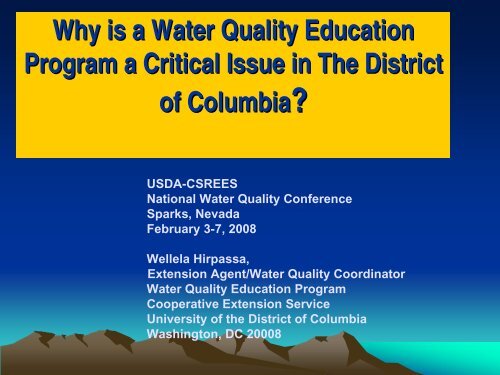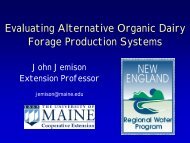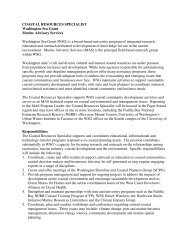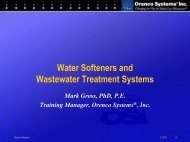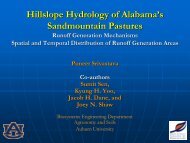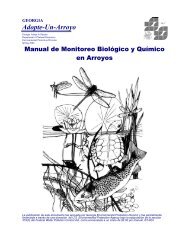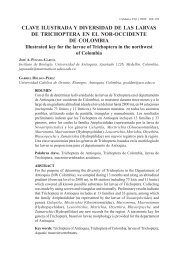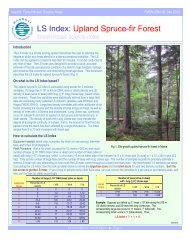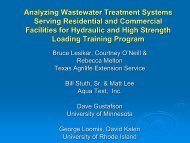Why is a Water Quality Education Program a Critical Issue in the ...
Why is a Water Quality Education Program a Critical Issue in the ...
Why is a Water Quality Education Program a Critical Issue in the ...
Create successful ePaper yourself
Turn your PDF publications into a flip-book with our unique Google optimized e-Paper software.
<strong>Why</strong> <strong>is</strong> a <strong>Water</strong> <strong>Quality</strong> <strong>Education</strong><br />
<strong>Program</strong> a <strong>Critical</strong> <strong>Issue</strong> <strong>in</strong> The D<strong>is</strong>trict<br />
of Columbia<br />
USDA-CSREES<br />
National <strong>Water</strong> <strong>Quality</strong> Conference<br />
Sparks, Nevada<br />
February 3-7, 2008<br />
Wellela Hirpassa,<br />
Extension Agent/<strong>Water</strong> <strong>Quality</strong> Coord<strong>in</strong>ator<br />
<strong>Water</strong> <strong>Quality</strong> <strong>Education</strong> <strong>Program</strong><br />
Cooperative Extension Service<br />
University of <strong>the</strong> D<strong>is</strong>trict of Columbia<br />
Wash<strong>in</strong>gton, DC 20008
Surface, Ground, and Dr<strong>in</strong>k<strong>in</strong>g <strong>Water</strong><br />
<strong>Quality</strong> <strong>in</strong> <strong>the</strong> D<strong>is</strong>trict of Columbia<br />
Federal water quality standards and regulation set and<br />
enforced by <strong>the</strong> Environmental Protection Agency (EPA)<br />
Local water quality standards and regulation set and enforced<br />
by DC Department of <strong>the</strong> Environment/ <strong>Water</strong> <strong>Quality</strong> Div<strong>is</strong>ion
<strong>Critical</strong> <strong>Issue</strong>s Associated with <strong>Water</strong><br />
<strong>Quality</strong> <strong>in</strong> <strong>the</strong> D<strong>is</strong>trict of Columbia<br />
Anacostia River <strong>is</strong> one of <strong>the</strong> top ten most polluted rivers <strong>in</strong> <strong>the</strong> Nation;<br />
Anacostia River <strong>is</strong> a tributary of <strong>the</strong> Potomac River which <strong>is</strong> <strong>the</strong> source of<br />
DC dr<strong>in</strong>k<strong>in</strong>g water;<br />
Recent lead contam<strong>in</strong>ation <strong>in</strong> DC dr<strong>in</strong>k<strong>in</strong>g water due to old lead based<br />
pipes and change <strong>in</strong> water treatment chem<strong>is</strong>try;<br />
Comb<strong>in</strong>ed Sewer Overflow System that d<strong>is</strong>charges raw sewage <strong>in</strong>to <strong>the</strong><br />
Rock Creek, Anacostia and Potomac Rivers with less than an <strong>in</strong>ch of<br />
ra<strong>in</strong>fall; and<br />
The commitment to clean up <strong>the</strong> Chesapeake Bay by both states and<br />
federal government <strong>in</strong> <strong>the</strong> bay watershed.
Population <strong>in</strong>crease vs. pollution<br />
‣Garbage and oils<br />
‣Constructions, Play grounds, roads,<br />
park<strong>in</strong>g lots Impervious spaces
Challenges<br />
CSOs<br />
‣Obsolete dra<strong>in</strong>age systems<br />
sewage overflow enters <strong>the</strong> nearest<br />
rivers
• Eutrophication:<br />
<strong>in</strong>creased nitrogen<br />
and phosphorus<br />
concentration<br />
• Oxygen Depletion:<br />
Death of Aquatic animals<br />
and sub-aquatic<br />
vegetations
Objectives<br />
To provide an overview of DC dr<strong>in</strong>k<strong>in</strong>g water quality treatment,<br />
regulation, and monitor<strong>in</strong>g process; and<br />
To highlight results of pre and post-tests from <strong>Water</strong> <strong>Quality</strong><br />
<strong>Education</strong> <strong>Program</strong> on DC Dr<strong>in</strong>k<strong>in</strong>g <strong>Water</strong> Lead Contam<strong>in</strong>ation<br />
workshop at DC Public Schools and Local Community<br />
Centers.
Overview of <strong>the</strong> Nation’s s Capital Dr<strong>in</strong>k<strong>in</strong>g <strong>Water</strong> Treatment and<br />
D<strong>is</strong>tribution System<br />
‣ The Source of Wash<strong>in</strong>gton DC dr<strong>in</strong>k<strong>in</strong>g water <strong>is</strong> <strong>the</strong> Potomac<br />
River<br />
Tributary of <strong>the</strong> Potomac River
Raw diverted water from Potomac River at Dalecarlia <strong>Water</strong> Treatment<br />
Plant before process<strong>in</strong>g
Dr<strong>in</strong>k<strong>in</strong>g <strong>Water</strong> <strong>Quality</strong> Processes<br />
‣Wash<strong>in</strong>gton Aqueduct Div<strong>is</strong>ion of <strong>the</strong> U.S. Army Corps of<br />
Eng<strong>in</strong>eers manages and operates <strong>Water</strong> Treatment Plants at<br />
McMillan and Dalecarlia <strong>in</strong> Wash<strong>in</strong>gton, DC;<br />
‣The D<strong>is</strong>trict of Columbia <strong>Water</strong> and Sewer Authority (DC<br />
WASA) buys treated water from <strong>the</strong> Wash<strong>in</strong>gton Aqueduct;<br />
‣WASA d<strong>is</strong>tributes and sells treated water to its customers<br />
<strong>in</strong> <strong>the</strong> D<strong>is</strong>trict of Columbia;
Dr<strong>in</strong>k<strong>in</strong>g <strong>Water</strong> <strong>Quality</strong> Processes<br />
‣WASA collects 210 samples/month fixed site and submits<br />
to Wash<strong>in</strong>gton Aqueduct for test<strong>in</strong>g;<br />
‣Wash<strong>in</strong>gton Aqueduct test for all EPA water quality<br />
parameters and sends results back to WASA;<br />
‣WASA submits results to DC Department of <strong>the</strong><br />
Environment/<strong>Water</strong> <strong>Quality</strong> Div<strong>is</strong>ion (DDOE) and EPA; and<br />
‣DDOE and EPA assess results for compliance.
Lead Contam<strong>in</strong>ation <strong>in</strong> DC<br />
Dr<strong>in</strong>k<strong>in</strong>g <strong>Water</strong><br />
Total pipes 55,067<br />
Excessive Lead<br />
contam<strong>in</strong>ation <strong>in</strong> dr<strong>in</strong>k<strong>in</strong>g<br />
water was reported:<br />
Number of lead Pipes<br />
25000<br />
20000<br />
15000<br />
10000<br />
5000<br />
In 2004<br />
2005<br />
2006<br />
2007<br />
0<br />
Removed<br />
L<strong>is</strong>ted to remove unknown status<br />
Lead pipes status<br />
•14,112 pipes removed<br />
•17,256 pipes on <strong>the</strong> l<strong>is</strong>t to be removed<br />
• 23,699 pipes unknown status
Cause of Lead Contam<strong>in</strong>ation <strong>in</strong> DC<br />
Dr<strong>in</strong>k<strong>in</strong>g <strong>Water</strong><br />
Presence of lead-based service pipe (old<br />
<strong>in</strong>frastructure)<br />
Change <strong>in</strong> DC d<strong>is</strong><strong>in</strong>fectant chem<strong>is</strong>try from<br />
chlor<strong>in</strong>e to chloram<strong>in</strong>e that requires a base<br />
buffer<strong>in</strong>g treatment process
Survey Questions on Lead<br />
Contam<strong>in</strong>ation <strong>in</strong> DC Dr<strong>in</strong>k<strong>in</strong>g <strong>Water</strong><br />
<strong>Why</strong> <strong>is</strong> lead a problem<br />
How does lead get <strong>in</strong>to dr<strong>in</strong>k<strong>in</strong>g water<br />
How can I tell if my water conta<strong>in</strong>s too<br />
much lead<br />
Do you know <strong>the</strong> source of DC dr<strong>in</strong>k<strong>in</strong>g<br />
water
Results of Surveys from DC Public schools<br />
Site<br />
# of<br />
Participant<br />
Pretest<br />
Score<br />
(%)<br />
Posttest<br />
Score<br />
(%)<br />
Elem.<br />
Schools<br />
90 5% 80%<br />
High<br />
Schools<br />
200 15% 90%
Results of Surveys from Community Centers<br />
Site<br />
# of<br />
Participant<br />
Pre-test<br />
Score (%)<br />
Post-test<br />
Score<br />
(%)<br />
Fort<br />
Dav<strong>is</strong><br />
(Ward 7)<br />
Turkey<br />
Thicket<br />
(Ward 5)<br />
Kennedy<br />
(Ward 2)<br />
50 5% 80%<br />
35 10% 90%<br />
42 8% 75%<br />
Greenleaf<br />
(Ward 6)<br />
8 2% 90%
‣ High school students learn<strong>in</strong>g how to measure pH of water and data record<strong>in</strong>g
Benefits of <strong>Water</strong> <strong>Quality</strong> <strong>Education</strong><br />
• Increases awareness of r<strong>is</strong>ks associated with<br />
poor water quality;<br />
• Increases knowledge regard<strong>in</strong>g <strong>the</strong> functions of<br />
water to nutrition, health and <strong>the</strong> environment;<br />
• Reduces environmental pollution;<br />
• Reduces water treatment cost;<br />
• Reduces public health r<strong>is</strong>ks; and<br />
• Change public behavior to adopt manag<strong>in</strong>g<br />
water resources
Summary<br />
• Pre-test data show that both students and community residents <strong>in</strong><br />
<strong>the</strong> D<strong>is</strong>trict of Columbia do not know basic <strong>in</strong>formation regard<strong>in</strong>g<br />
<strong>the</strong>ir dr<strong>in</strong>k<strong>in</strong>g, ground and surface water quality;<br />
• Post-test data <strong>in</strong>dicated that basic concepts were acquired after<br />
water quality education workshop; and<br />
• Allocat<strong>in</strong>g more funds to educate <strong>the</strong> community about <strong>the</strong>ir role <strong>in</strong><br />
monitor<strong>in</strong>g water quality <strong>is</strong> a critical <strong>is</strong>sue that can lower non-po<strong>in</strong>t<br />
source pollution and eventually reduce water quality treatment cost.<br />
whirpassa@udc.edu


